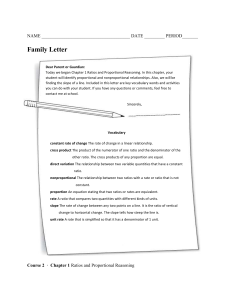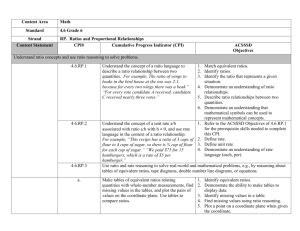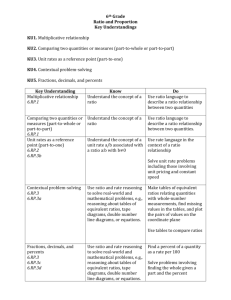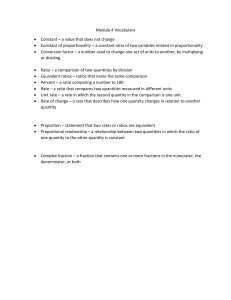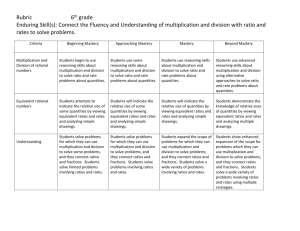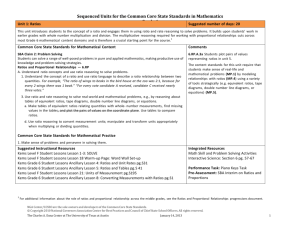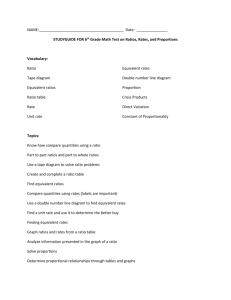HCPSS Curriculum Framework Grade 6 Unit 1
advertisement
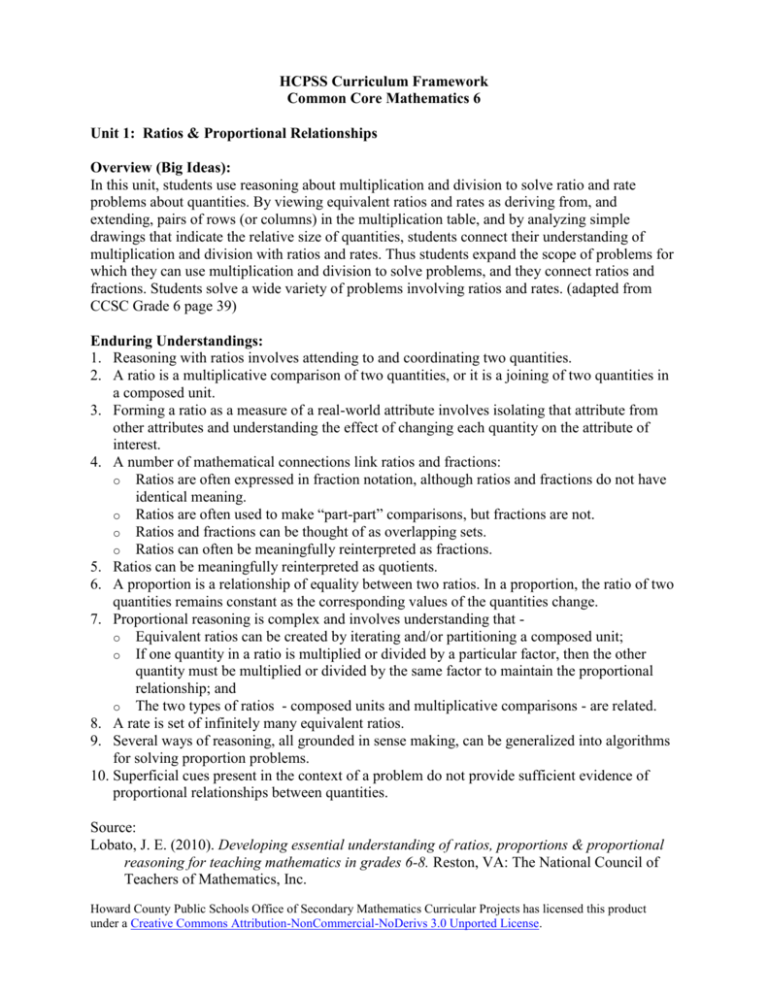
HCPSS Curriculum Framework Common Core Mathematics 6 Unit 1: Ratios & Proportional Relationships Overview (Big Ideas): In this unit, students use reasoning about multiplication and division to solve ratio and rate problems about quantities. By viewing equivalent ratios and rates as deriving from, and extending, pairs of rows (or columns) in the multiplication table, and by analyzing simple drawings that indicate the relative size of quantities, students connect their understanding of multiplication and division with ratios and rates. Thus students expand the scope of problems for which they can use multiplication and division to solve problems, and they connect ratios and fractions. Students solve a wide variety of problems involving ratios and rates. (adapted from CCSC Grade 6 page 39) Enduring Understandings: 1. Reasoning with ratios involves attending to and coordinating two quantities. 2. A ratio is a multiplicative comparison of two quantities, or it is a joining of two quantities in a composed unit. 3. Forming a ratio as a measure of a real-world attribute involves isolating that attribute from other attributes and understanding the effect of changing each quantity on the attribute of interest. 4. A number of mathematical connections link ratios and fractions: o Ratios are often expressed in fraction notation, although ratios and fractions do not have identical meaning. o Ratios are often used to make “part-part” comparisons, but fractions are not. o Ratios and fractions can be thought of as overlapping sets. o Ratios can often be meaningfully reinterpreted as fractions. 5. Ratios can be meaningfully reinterpreted as quotients. 6. A proportion is a relationship of equality between two ratios. In a proportion, the ratio of two quantities remains constant as the corresponding values of the quantities change. 7. Proportional reasoning is complex and involves understanding that o Equivalent ratios can be created by iterating and/or partitioning a composed unit; o If one quantity in a ratio is multiplied or divided by a particular factor, then the other quantity must be multiplied or divided by the same factor to maintain the proportional relationship; and o The two types of ratios - composed units and multiplicative comparisons - are related. 8. A rate is set of infinitely many equivalent ratios. 9. Several ways of reasoning, all grounded in sense making, can be generalized into algorithms for solving proportion problems. 10. Superficial cues present in the context of a problem do not provide sufficient evidence of proportional relationships between quantities. Source: Lobato, J. E. (2010). Developing essential understanding of ratios, proportions & proportional reasoning for teaching mathematics in grades 6-8. Reston, VA: The National Council of Teachers of Mathematics, Inc. Howard County Public Schools Office of Secondary Mathematics Curricular Projects has licensed this product under a Creative Commons Attribution-NonCommercial-NoDerivs 3.0 Unported License. Essential Questions: o What is the connection between a ratio and a fraction? o Why is it important to know how to solve for unit rates? o How is a ratio or rate used to compare two quantities or values? o How and where are ratios and rates used in the real world? o How can I model and represent rates and ratios? o What are similarities and differences between fractions and ratios? Curriculum Standards: 6.RP.A Understand ratio concepts and use ratio reasoning to solve problems. 1. Understand the concept of a ratio and use ratio language to describe a ratio relationship between two quantities. For example, “The ratio of wings to beaks in the bird house at the zoo was 2:1, because for every 2 wings there was 1 beak.” “For every vote candidate A received, candidate C received nearly three votes.” 2. Understand the concept of a unit rate a/b associated with a ratio a:b with b 0 , and use rate language in the context of a ratio relationship. For example, “This recipe has a ratio of 3 cups of flour to 4 cups of sugar, so there is a 3/4 cup of flour for each cup of sugar.” “We paid $75 for 15 hamburgers, which is a rate of $5 per hamburger.” 3. Use ratio and rate reasoning to solve real-world and mathematical problems, e.g., by reasoning about tables of equivalent ratios, tape diagrams, double number line diagrams, or equations. a. Make tables of equivalent ratios relating quantities with whole-number measurements, find missing values in the tables, and plot the pairs of values on the coordinate plane. Use tables to compare ratios. b. Solve unit rate problems including those involving unit pricing and constant speed. For example, if it took 7 hours to mow 4 lawns, then at that rate, how many lawns could be mowed in 35 hours? At what rate were lawns being mowed? c. Find a percent of a quantity as a rate per 100 (e.g. 30% of a quantity means 30/100 times the quantity); solve problems involving finding the whole, given a part and the percent. d. Use ratio reasoning to convert measurement units; manipulate and transform units appropriately when multiplying or dividing quantities. Common Misconceptions: o Students may focus on only one quantity instead of the relationship between two quantities. o Students may be unfamiliar with multiple strategies, including ratio tables. o Students may confuse mathematical terms such as ratio, rate, unit rate and percent. o Students may not understand how to set up a table or graph. o Students may not understand the difference between an additive relationship and a multiplicative relationship. Howard County Public Schools Office of Secondary Mathematics Curricular Projects has licensed this product under a Creative Commons Attribution-NonCommercial-NoDerivs 3.0 Unported License.
